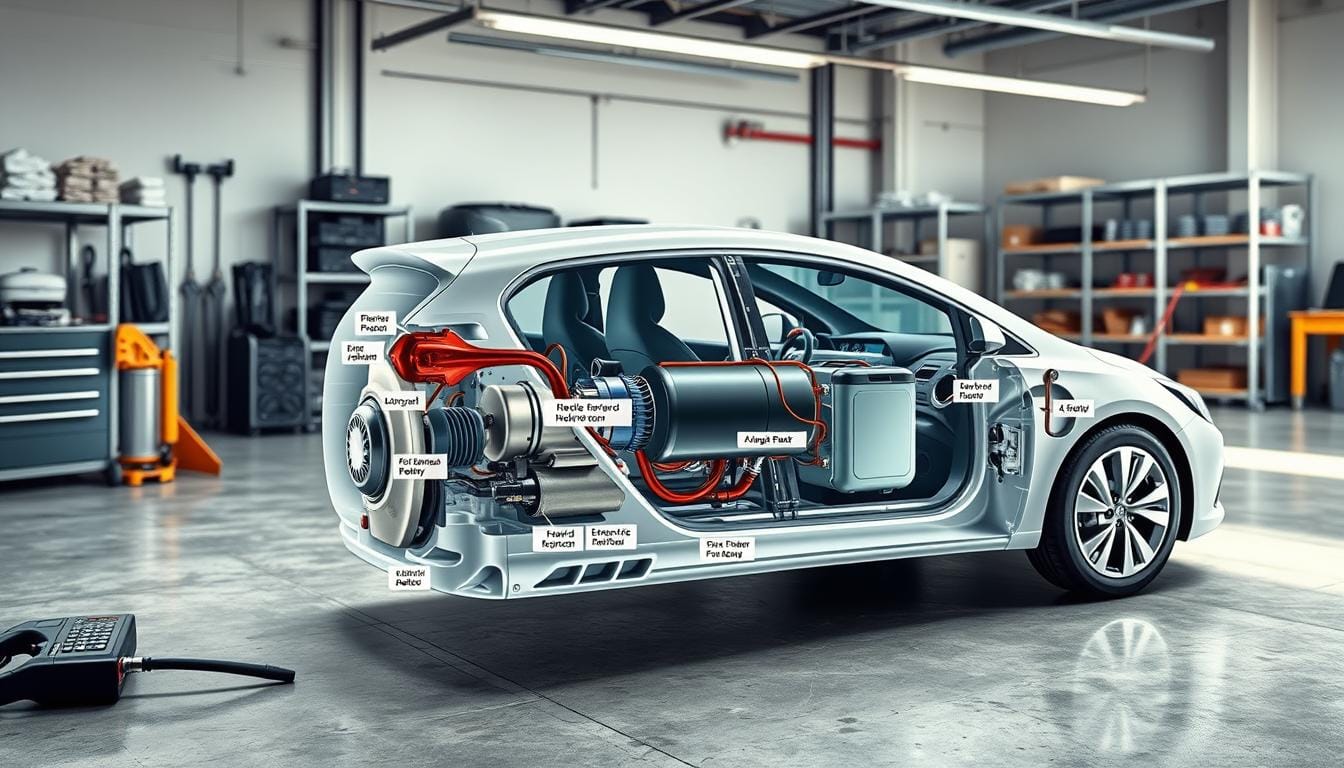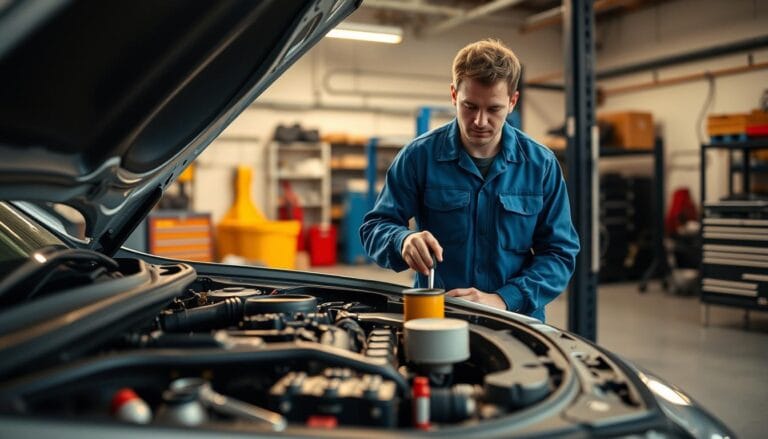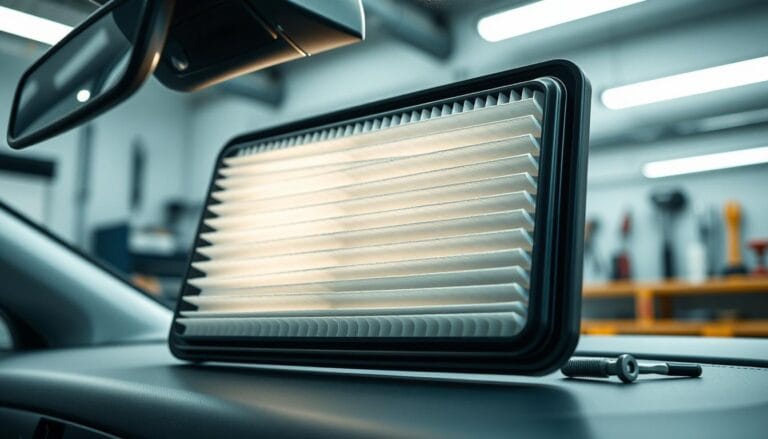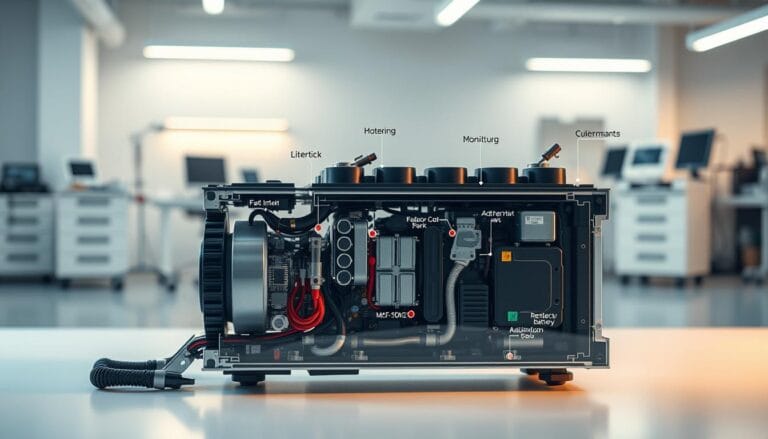Hybrid Fuel System Maintenance: Avoid Costly Repairs
Switching to a hybrid vehicle was exciting for me, thanks to the fuel savings. But, I was worried about maintenance. I soon learned that Hybrid Fuel System Maintenance is key to keeping your car running well.
Hybrid cars mix electric and gasoline tech, needing special care. They’re not like regular cars. A detailed fuel tank check and knowing your hybrid’s systems can stop pricey fixes later.
Keeping up with hybrid maintenance is a must. With battery replacement costs from $2,000 to $10,000, it’s a smart money move. It’s not just about keeping your car running; it’s about saving money too.
Table of Contents
Understanding Hybrid Fuel Systems
Hybrid vehicles are a smart way to travel, using the latest tech and caring for our planet. They use two power sources to save fuel and cut down on emissions.
A hybrid fuel system combines a gas engine and an electric motor. This mix improves how much fuel you use and how well your car performs.
What Defines a Hybrid Fuel System?
A hybrid fuel system has key parts:
- Internal combustion engine
- Electric motor
- High-voltage battery pack
- Power control unit
- Regenerative braking system
Types of Hybrid Fuel Systems
There are different hybrid setups, each with its own perks:
- Parallel Hybrids: Both engine and motor power the car
- Series Hybrids: The engine makes electricity for the motor
- Plug-in Hybrids: Can be charged outside and run on electric
Replacing hybrid batteries is important for good car performance. With the right care, hybrid batteries can last from 100,000 to 200,000 miles.
Hybrid technology keeps getting better, making travel more efficient and kinder to our planet.
Importance of Regular Maintenance
Maintaining your hybrid vehicle is more than just avoiding breakdowns. It’s about protecting your investment and keeping it running at its best. Regular maintenance is essential for a smooth and efficient ride.
Your hybrid’s life span depends on regular care. A well-kept vehicle saves you money by avoiding costly repairs and keeping fuel efficiency high.
Benefits of Routine Checks
Routine maintenance brings many benefits for hybrid owners:
- Extend battery life through regular inspections
- Optimize fuel efficiency
- Prevent costly fuel filter replacement
- Reduce the risk of unexpected fuel pump repair
Saving on Future Repairs
Proactive maintenance can save you from expensive repairs. Here are some key maintenance points:
- Tire rotations every 5,000 to 7,500 miles
- Oil changes around 10,000 miles
- Air filter replacements every 10,000 miles
- Battery health checks annually
Regular maintenance keeps your hybrid performing well and its value high. A service history can attract buyers and increase the price.
Remember: Prevention is always more cost-effective than repair.
Key Components of Hybrid Systems
Hybrid vehicles mix electrical and mechanical tech in a smart way. Knowing the important parts helps keep your car running well. Hybrid system maintenance needs focus on several key areas.
Battery Health and Maintenance
Your hybrid’s battery pack is its main strength. It lasts 8-15 years with the right care. Regular checks can stop sudden failures and save money. Here are some key tips:
- Do voltage and capacity tests every quarter
- Stay away from extreme temperatures
- Keep charging consistent
- Watch battery performance signs
Internal Combustion Engine Care
Even with electric parts, hybrids use traditional engines too. Cleaning fuel injectors is key for good performance. Watch out for fuel line leaks, as they hurt your car’s fuel use.
Electrical System Monitoring
The electrical system in hybrids needs special care. They get 50-60 miles per gallon, but only with good electrical system upkeep.
Regular checks can spot problems early, saving you money. Keeping an eye on electrical parts ensures your hybrid runs well and is eco-friendly.
Signs Your Hybrid System Needs Maintenance
Keeping your hybrid vehicle in top shape is key. You need to watch for warning signs to avoid expensive fixes. Spotting problems early keeps your car running smoothly.
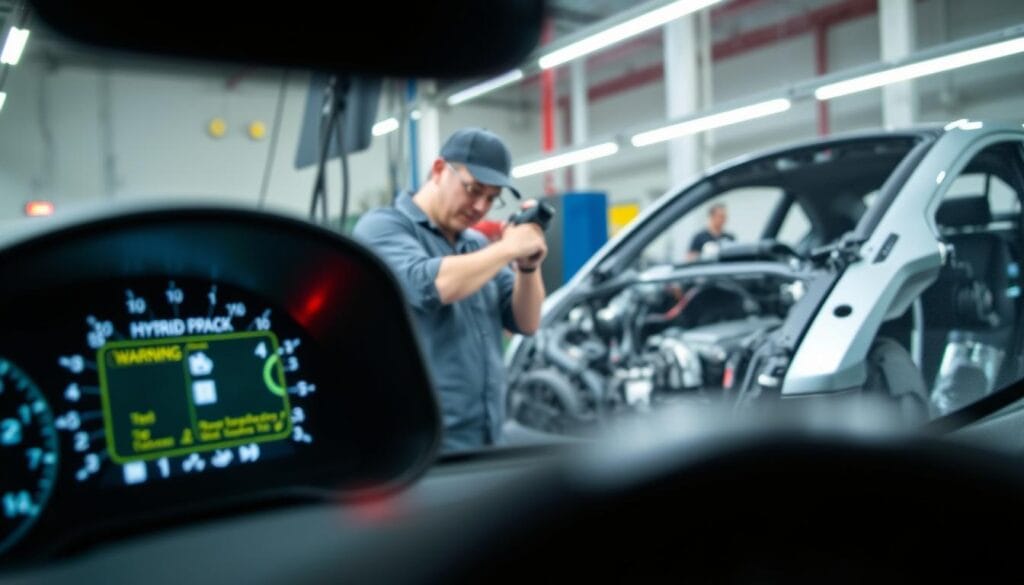
Your hybrid system tells you when something’s wrong through various signs. Catching these signals early can prevent big repair bills and keep your car running well.
Warning Lights on Dashboard
Dashboard lights are your car’s way of saying, “Hey, something’s off.” Different lights mean different things:
- Red lights mean serious problems
- Amber lights hint at minor issues
- Specific lights for engine air filter needs
Decreased Fuel Efficiency
When your hybrid’s fuel use changes, it’s time for a check-up. Look out for:
- More trips to the gas station
- Lower miles per gallon
- Battery charge not lasting as long
Unusual Noises or Vibrations
Strange sounds or shakes mean something’s amiss. Get a pro to check it out if you hear:
- Grinding when you hit the gas
- Clicks from the battery area
- Shakes while driving
| Warning Sign | Potential Cause | Recommended Action |
|---|---|---|
| Battery Warning Light | Low Battery Performance | Schedule Diagnostic Check |
| Reduced Fuel Economy | Hybrid System Inefficiency | Comprehensive System Inspection |
| Unusual Noises | Mechanical Component Wear | Immediate Professional Evaluation |
Regular care and quick action to these signs can make your hybrid last longer. It also keeps it running at its best.
Best Practices for Hybrid Fuel System Maintenance
Keeping your hybrid vehicle in top shape is key to its performance and life. A good Hybrid Fuel System Maintenance plan can save you money and avoid sudden breakdowns.
Understanding your hybrid system’s needs is essential. Experts suggest sticking to a detailed maintenance schedule. This schedule covers both traditional and advanced tech parts.
Scheduled Maintenance Intervals
Your hybrid needs precise care at set times. Here’s a detailed maintenance schedule:
- Every 5,000 kilometres:
- Check oil levels
- Inspect cooling systems
- Look at electric motors
- Make sure battery connections are good
- Every 10,000 kilometres:
- Check brake pads
- Inspect the suspension system
- Check brake fluid levels
- Every 40,000 kilometres: Do a full battery system check
“Regular maintenance stops expensive hybrid repairs.”
Keeping Up with Software Updates
Software updates are vital for your hybrid’s performance. Makers often release updates that:
- Boost system efficiency
- Fix software problems
- Improve battery use
- Update fuel tank checks
Regular fuel tank checks and software updates keep your hybrid running smoothly. This ensures it lasts longer.
Tools for Effective Maintenance
Keeping your hybrid vehicle in top shape needs the right tools and diagnostic gear. Knowing which tools are key can help your hybrid run smoothly. It might even prevent the need for expensive battery replacements.
Hybrid owners should get a detailed toolkit that’s more than just basic car maintenance stuff. Here are the must-haves for taking care of your hybrid:
- Digital multimeter for electrical system checks
- OBD-II scanner made for hybrids
- Insulated safety gloves
- High-voltage testing tools
- Battery voltage checker
Essential Diagnostic Tools
Modern hybrids have advanced onboard diagnostic systems. An OBD-II scanner is your go-to for emissions tests and spotting system problems. These scanners pull trouble codes fast, showing you how your car is doing.
Professional-Grade Diagnostic Equipment
For deeper checks, you need hybrid-specific tools. These pro-grade devices do detailed emissions testing and catch small performance changes that regular scanners might miss.
Getting the right diagnostic tools can save you a lot of money on repairs later on.
When picking diagnostic tools, think about if they match your hybrid model and how detailed they can be. Some top scanners let you watch data in real-time. This is super helpful for keeping up with maintenance.
Professional Maintenance vs. DIY
Maintaining a hybrid vehicle needs a smart mix of expert help and your own efforts. Knowing when to call a pro and when to do it yourself can save money and keep your car in top shape.
When to Seek Professional Help
Some hybrid maintenance tasks need special skills and a pro’s touch. Jobs like fuel filter replacement and fuel pump repair require the right tools and know-how. Experts can:
- Find and fix tricky electrical and mechanical problems
- Use special tools for hybrid cars
- Make sure repairs are covered by warranty
- Stop damage to your car’s complex systems
Pros and Cons of DIY Maintenance
DIY maintenance can save you money, but it’s important to know your limits. Simple tasks are okay, but leave the hard stuff to the pros.
| DIY Tasks | Professional Tasks |
|---|---|
| Tire pressure checks | Fuel system diagnostics |
| Air filter replacement | Battery system maintenance |
| Windshield wiper changes | Electrical system repairs |
By knowing when to DIY and when to call a pro, you can keep your hybrid running well. And you’ll avoid expensive mistakes.
Common Mistakes to Avoid
Keeping your hybrid vehicle in top shape is key. Many owners make mistakes that hurt their car’s performance and life. Knowing these mistakes can save you a lot of time and money.

Ignoring Warning Signs
Disregarding dashboard warnings is a big mistake for hybrid owners. Not cleaning fuel injectors can cause serious engine issues. Signs like rough idling, lower fuel efficiency, or odd noises should not be ignored.
- Watch for dashboard warning lights
- Pay attention to changes in vehicle performance
- Address possible fuel line leaks right away
Skipping Routine Maintenance Checks
Regular maintenance is vital for hybrid cars. Skipping these checks can lead to expensive fixes and lower efficiency. It’s wise to fix problems early to avoid bigger issues.
| Maintenance Area | Recommended Interval | Potential Consequences of Neglect |
|---|---|---|
| Fuel Injector Cleaning | Every 30,000 miles | Engine performance loss |
| Battery Inspection | Annually | Reduced battery life |
| Fuel Line Leak Check | Every 6 months | Potential safety hazards |
Being proactive with your hybrid’s care can prevent costly repairs and keep it running well. Remember, prevention is always more cost-effective than extensive repairs.
Hybrid vehicles are sophisticated machines that require consistent, knowledgeable care to maintain their efficiency and reliability.
Conclusion: Maintaining Your Hybrid Fuel System
Hybrid vehicle sales have jumped by 63%, and electric vehicle adoption is growing. It’s key to understand how to maintain your investment. Hybrid ownership is more than just driving an eco-friendly car. Regular fuel system checks and timely engine air filter changes boost your car’s performance and life.
Keeping your hybrid in top shape is all about proactive care. Regular inspections and following the manufacturer’s advice can extend your high-voltage battery’s life. This can save you a lot of money, as avoiding big repairs can cost over $1,000. A clean air filter can also improve fuel efficiency by up to 10%.
Adopting a thorough maintenance routine keeps your hybrid running smoothly. Regular updates, proper battery care, and attention to detail can cut emissions by 30-50% compared to gas cars. Hybrid owners see a 70% drop in fuel costs, showing the value of regular maintenance.
Your Maintenance Roadmap
Your hybrid is a complex system that needs special care. Stay informed, proactive, and committed to regular maintenance. This will ensure your hybrid performs well, efficiently, and lasts longer. Always consult certified experts, follow service schedules, and see maintenance as an investment in your driving pleasure.

